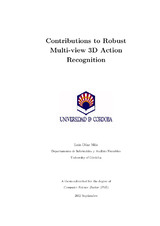Contributions to Robust Multi-view 3D Action Recognition
Autor
Díaz Más, Luis
Director/es
Madrid-Cuevas, F.J.Muñoz-Salinas, Rafael
Editor
Universidad de Córdoba, Servicio de PublicacionesFecha
2012Materia
Reconstrucción tridimensionalTécnica SfS
METS:
Mostrar el registro METSPREMIS:
Mostrar el registro PREMISMetadatos
Mostrar el registro completo del ítemResumen
This thesis focus on human action recognition using volumetric reconstructions
obtained from multiple monocular cameras. The problem of action recognition has been
addressed using di erent approaches, both in the 2D and 3D domains, and using one or
multiple views. However, the development of robust recognition methods, independent
from the view employed, remains an open problem.
Multi-view approaches allow to exploit 3D information to improve the recognition
performance. Nevertheless, manipulating the large amount of information of 3D representations
poses a major problem. As a consequence, standard dimensionality reduction
techniques must be applied prior to the use of machine learning approaches. The rst
contribution of this work is a new descriptor of volumetric information that can be further
reduced using standard Dimensionality Reduction techniques in both holistic and
sequential recognition approaches. However, the descriptor itself reduces the amount of
data up to an order of magnitude (compared to previous descriptors) without a ecting
to the classi cation performance.
The descriptor represents the volumetric information obtained by SfS techniques.
However, this family of techniques are highly in
uenced by errors in the segmentation
process (e.g., undersegmentation causes false negatives in the reconstructed volumes)
so that the recognition performance is highly a ected by this rst step. The second
contribution of this work is a new SfS technique (named SfSDS) that employs the
Dempster-Shafer theory to fuse evidences provided by multiple cameras. The central
idea is to consider the relative position between cameras so as to deal with inconsistent
silhouettes and obtain robust volumetric reconstructions.
The basic SfS technique still have a main drawback, it requires the whole volume
to be analized in order to obtain the reconstruction. On the other hand, octree-based representations allows to save memory and time employing a dynamic tree structure
where only occupied nodes are stored. Nevertheless, applying the SfS method to octreebased
representations is not straightforward. The nal contribution of this work is a
method for generating octrees using our proposed SfSDS technique so as to obtain
robust and compact volumetric representations. Esta tesis se centra en el reconocimiento de acciones humanas usando reconstrucciones
volum etricas obtenidas a partir de m ultiples c amaras monoculares. El problema
del reconocimiento de acciones ha sido tratado usando diferentes enfoques, en los dominios
2D y 3D, y usando una o varias vistas. No obstante, el desarrollo de m etodos de
reconocimiento robustos, independientes de la vista empleada, sigue siendo un problema
abierto.
Los enfoques multi-vista permiten explotar la informaci on 3D para mejorar el
rendimiento del reconocimiento. Sin embargo, manipular las grandes cantidades de
informaci on de las representaciones 3D plantea un importante problema. Como consecuencia,
deben ser aplicadas t ecnicas est andar de reducci on de dimensionalidad con
anterioridad al uso de propuestas de aprendizaje. La primera contribuci on de este trabajo
es un nuevo descriptor de informaci on volum etrica que puede ser posteriormente
reducido mediante t ecnicas est andar de reducci on de dimensionalidad en los enfoques
de reconocimiento hol sticos y secuenciales. El descriptor, por si mismo, reduce la
cantidad de datos hasta en un orden de magnitud (en comparaci on con descriptores
previos) sin afectar al rendimiento de clasi caci on.
El descriptor representa la informaci on volum etrica obtenida en t ecnicas SfS. Sin
embargo, esta familia de t ecnicas est a altamente in
uenciada por los errores en el
proceso de segmentaci on (p.e., una sub-segmentaci on causa falsos negativos en los
vol umenes reconstruidos) de forma que el rendimiento del reconocimiento est a signi cativamente
afectado por este primer paso. La segunda contribuci on de este trabajo es una
nueva t ecnica SfS (denominada SfSDS) que emplea la teor a de Dempster-Shafer para
fusionar evidencias proporcionadas por m ultiples c amaras. La idea central consiste en considerar la posici on relativa entre c amaras de forma que se traten las inconsistencias
en las siluetas y se obtenga reconstrucciones volum etricas robustas.
La t ecnica SfS b asica sigue teniendo un inconveniente principal; requiere que el
volumen completo sea analizado para obtener la reconstrucci on. Por otro lado, las
representaciones basadas en octrees permiten salvar memoria y tiempo empleando una
estructura de arbol din amica donde s olo se almacenan los nodos ocupados. No obstante,
la aplicaci on del m etodo SfS a representaciones basadas en octrees no es directa.
La contribuci on nal de este trabajo es un m etodo para la generaci on de octrees
usando nuestra t ecnica SfSDS propuesta de forma que se obtengan representaciones
volum etricas robustas y compactas.

